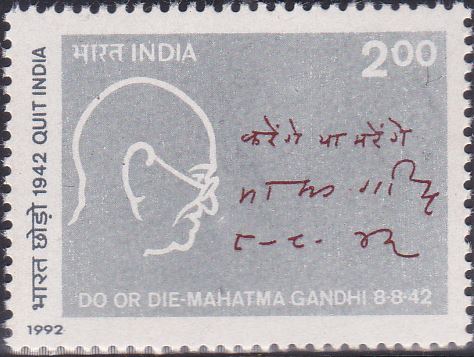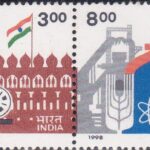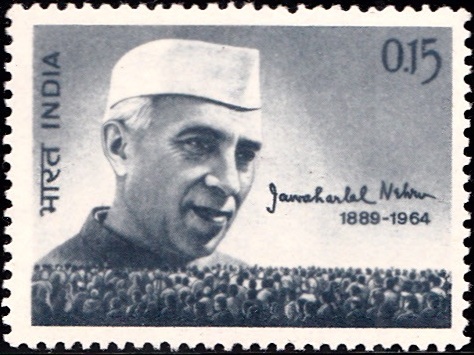
Quit India Movement 1967
A commemorative postage stamp on the Silver Jubilee of the Quit India Movement of 1942 :
 Issued by India
Issued by India
Issued on Oct 1, 1967
Issued for : On the 9th August this year was celebrated the 25th anniversary of the historic “Quit India” movement. The Posts & Telegraphs Department pays homage to all the heroes and martyrs who laid down their lives in the struggle, by bringing out a special postage stamp on the 1st October, 1967.
Design : The stamp depicts the Martyrs’ Memorial situated outside the Secretariat Building, Patna of seven students who lost their lives in the Quit India movement while attempting to hoist the National flag. The Memorial was sculptured by Shri Devi Prasad Roy Chowdhury.
Type : Stamp, Mint Condition
Colour : Maroon
Denomination : 15 Paise
Overall Size : 4.06 x 2.28 cms.
Printing Size : 3.80 x 2.00 cms.
Perforation : 14 x 14½
Paper : unwatermarked paper
Number Printed : 40,00,000
Number per issue sheet : 50
Printing Process : Photogravure
Designed and Printed at : India Security Press
About :
- “Here is a mantra, a short one that I give you. You may imprint it on your hearts and let every breath of yours give expression to it. The mantra is ‘Do or Die‘. We shall either free India or die in the attempt. We shall not live to see the perpetuation of our slavery.“
- It was with these inspiring words that Mahatma Gandhi in the speech he delivered just after the passing of the historic “Quit India” resolution by the All-India Congress Committee on 8th August, 1942 at Bombay ushered in a new phase in the glorious struggle for India‘s freedom.
- The August Revolution was a historic event and it had a tremendous influence on the future of Indian nationalism. The revolution drew the attention of the world and lifted to the moral plane the question of Indian Independence. At the time of the passing of the Resolution by the All-India Congress Committee, the world was passing through a critical phase during the Second World War. Rangoon had fallen and the Japanese were poised for attack on the borders of India. Gandhiji, Panditji and the other national leaders felt that it was all the more necessary for India to be free to meet the challenge posed by the fascist aggression. Thus the resolution set forth:–
“The peril of today, therefore, necessitates the independence of India and the ending of British domination. No future promises or guarantees can affect the present situation or meet that peril. They cannot produce the needed psychological effect on the mind of the masses. Only the glow of freedom now can release that energy and enthusiasm in millions of people which will immediately transform the nature of the war. The A.I.C.C. therefore, repeats with all emphasis its demand for the withdrawal of British power from India.“ - The resolution authorised Gandhiji to lead a mass movement on non-violent lines for achieving independence. Thus was a revolutionary instinct kindled and forged amongst the masses. The passing of the resolution was immediately followed by the arrest of Gandhiji, Panditji, Sardar Patel, Rajendra Babu, Maulana Azad and all other prominent leaders and the adoption of other stern measures by the British Government. These repressive measures led to a widespread revolutionary upsurge of the people. The Government resorted to the burning of villages, machine-gunning and aerial attacks on the people to suppress the uprising; which resulted in killing of thousands of men, women and children. The movement brought forth a host of leaders and martyrs who performed great deeds of heroism and sacrifice. This mass revolutionary movement was a dangerous portent for an alien rule and manifested the new and resurgent forces of nationalism that were at work. It ultimately culminated in the grant of independence to India which Pandit Jawaharlal Nehru ushered in with the memorable words on the night of the 14th/15th August, 1947 addressed to the Constituent Assembly of the Indian Union :–
“At the stroke of the midnight hour, when the world sleeps, India will awake to life and freedom. A moment comes, which comes but rarely in history, when we step out from the old to the new, when an age ends, and when the soul of a nation long suppressed, finds utterance……..“ - Not only did the “Quit India” movement kindle a universal desire for freedom by inspiring the people to great deeds of heroism and sacrifice but it created new dimensions in a subject people’s struggle for freedom through non-violent and honourable methods. It was this which made Francis Gunthur write :–
“The Indian Revolution is the first entirely above-ground revolution in history that has undeviatingly followed a policy of using wholly honourable means to achieve its ends – a revolution in which the means were held to be as important as the end – a revolution without hate, without terror, without a spy system, without treachery, without assassination – a revolution in which all the habitual evils of revolution were ruled out.“








[…] Sabha from Rajapur Parliamentary Constituency, Maharashtra. He went underground during the ‘Quit India‘ movement in 1942. He was eventually arrested and sent to jail. He was elected as the […]
[…] words that Mahatma Gandhi in the speech he delivered just after the passing of the historic ‘Quit India’ resolution by the All-India Congress Committee on 8th August, 1942 at Bombay ushered in a new […]
[…] 1942, when Mahatma Gandhi gave the call “Quit India” and the slogan “Do or die“, Hemu Kalani also joined the mass movement. There was […]
[…] in World War II by the British without consulting Indian opinion, Giri was in the forefront of the Quit India Movement and was sentenced to 15 months’ rigorous imprisonment. In 1946 Giri was re-elected to the […]
[…] he was studying in Schwartz Higher Secondary School, Ramanathapuram, he dedicated himself to the Quit India Movement in […]
[…] Mahatma Gandhi and got involved in the Freedom Movement. He participated in Salt Agitation and Quit India movement. He was put in Shivani Jail. He came to Amravati (Maharashtra) in 1917 & made it his […]
[…] and accepted him as his “Political Guru”. Biju Patnaik’s political career began during the Quit India Movement when he collaborated with underground leaders and was imprisoned for thirty months. During the […]
[…] all. Husain Ahmad Madani also took an active part in the Civil Disobedience Movement in 1932 and in Quit India Movement in 1942 and was imprisoned on many […]
[…] National Government called Tamralipta Jatiya Sarkar which was formed in Tamluk in the wake of the Quit India Movement. In the face of the atrocities unleashed by the British government, the people of Tamluk […]
[…] the Defence of India Ordinance in 1940, and was released after 18 months. He was active in the Quit India Movement also, operating from underground. He mobilised support for the movement from Afghanistan and […]